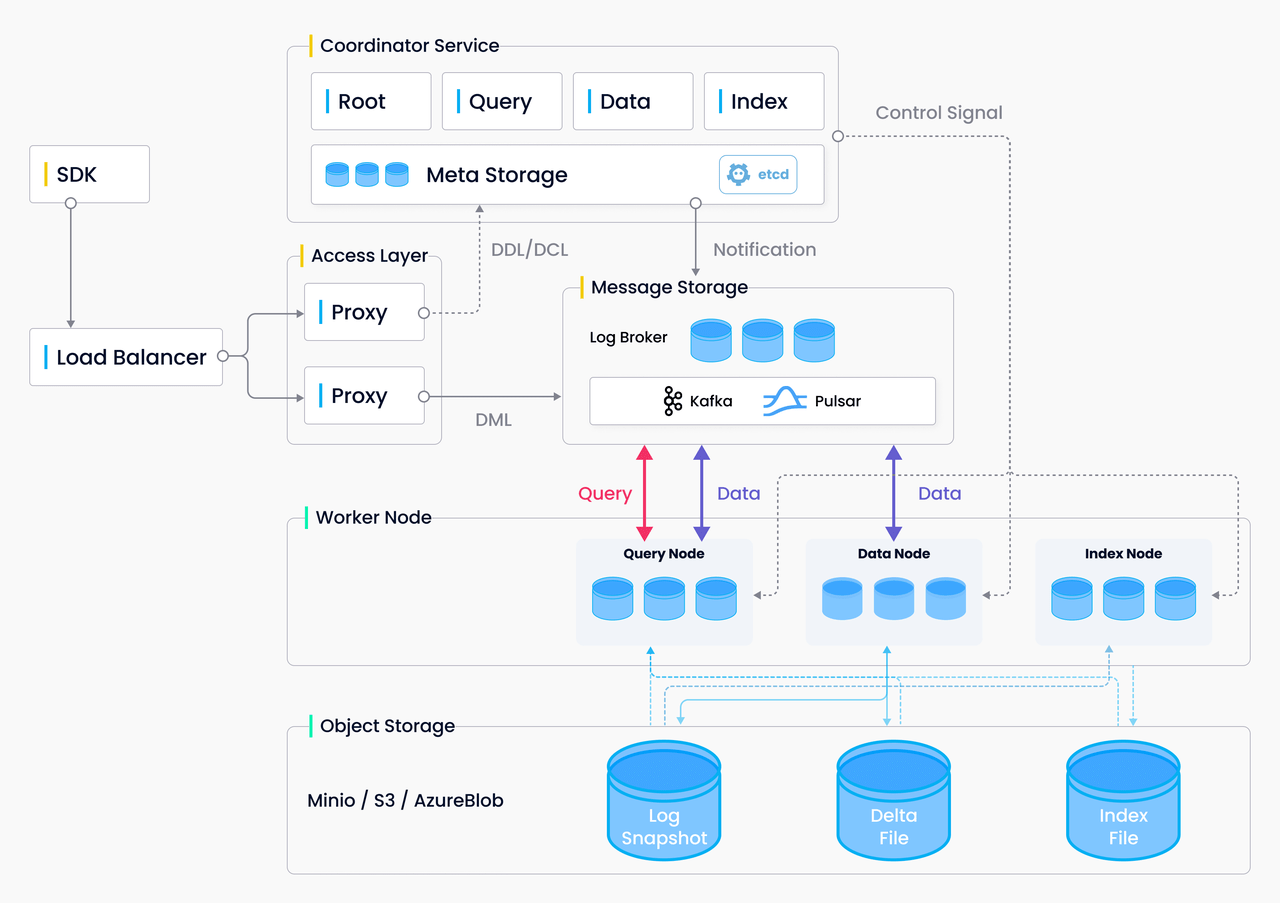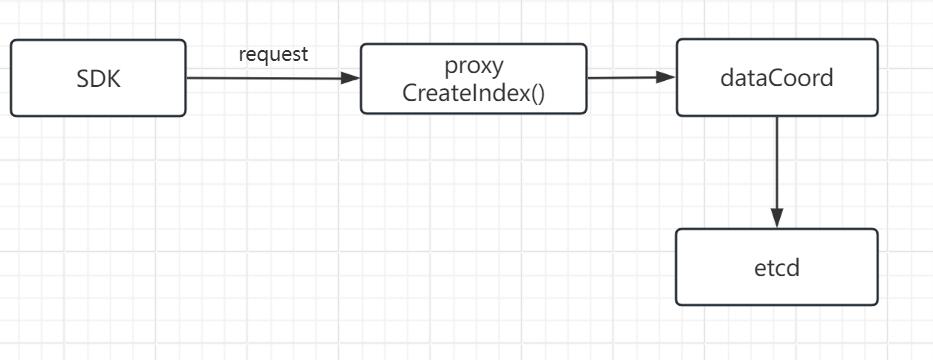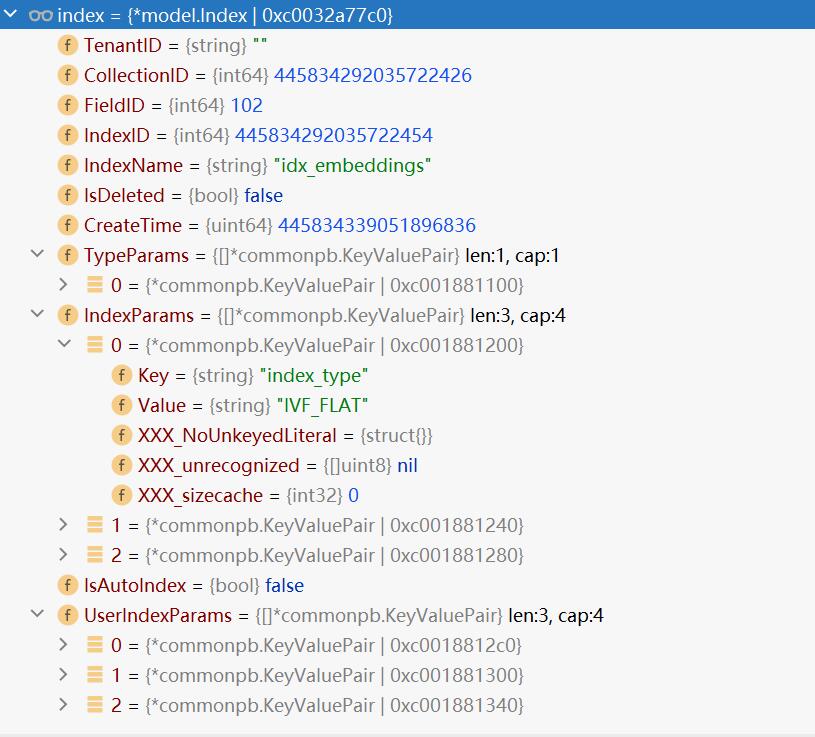CreateIndex API执行流程源码解析
milvus版本:v2.3.2
整体架构:

CreateIndex 的数据流向:

1.客户端sdk发出CreateIndex API请求。
import numpy as np
from pymilvus import (
connections,
FieldSchema, CollectionSchema, DataType,
Collection,
)
num_entities, dim = 2000, 8
print("start connecting to Milvus")
connections.connect("default", host="192.168.230.71", port="19530")
fields = [
FieldSchema(name="pk", dtype=DataType.VARCHAR, is_primary=True, auto_id=False, max_length=100),
FieldSchema(name="random", dtype=DataType.DOUBLE),
FieldSchema(name="embeddings", dtype=DataType.FLOAT_VECTOR, dim=dim)
]
schema = CollectionSchema(fields, "hello_milvus is the simplest demo to introduce the APIs")
print("Create collection `hello_milvus`")
hello_milvus = Collection("hello_milvus", schema, consistency_level="Strong")
print("Start inserting entities")
rng = np.random.default_rng(seed=19530)
entities = [
# provide the pk field because `auto_id` is set to False
[str(i) for i in range(num_entities)],
rng.random(num_entities).tolist(), # field random, only supports list
rng.random((num_entities, dim)), # field embeddings, supports numpy.ndarray and list
]
insert_result = hello_milvus.insert(entities)
hello_milvus.flush()
print("Start Creating index IVF_FLAT")
index = {
"index_type": "IVF_FLAT",
"metric_type": "L2",
"params": {
"nlist": 8},
}
hello_milvus.create_index("embeddings", index,index_name="idx_embeddings")
客户端SDK向proxy发送一个CreateIndex API请求,在embeddings列上创建一个名为idx_embeddings的索引。
2.客户端接受API请求,将request封装为createIndexTask,并压入ddQueue队列。
代码路径:internal\proxy\impl.go
// CreateIndex create index for collection.
func (node *Proxy) CreateIndex(ctx context.Context, request *milvuspb.CreateIndexRequest) (*commonpb.Status, error) {
......
// request封装为task
cit := &createIndexTask{
ctx: ctx,
Condition: NewTaskCondition(ctx),
req: request,
rootCoord: node.rootCoord,
datacoord: node.dataCoord,
replicateMsgStream: node.replicateMsgStream,
}
......
// 将task压入ddQueue队列
if err := node.sched.ddQueue.Enqueue(cit); err != nil {
......
}
......
// 等待cct执行完
if err := cit.WaitToFinish(); err != nil {
......
}
......
}
3.执行createIndexTask的3个方法PreExecute、Execute、PostExecute。
PreExecute()一般为参数校验等工作。
Execute()一般为真正执行逻辑。
代码路径:internal\proxy\task_index.go
func (cit *createIndexTask) Execute(ctx context.Context) error {
......
req := &indexpb.CreateIndexRequest{
CollectionID: cit.collectionID,
FieldID: cit.fieldSchema.GetFieldID(),
IndexName: cit.req.GetIndexName(),
TypeParams: cit.newTypeParams,
IndexParams: cit.newIndexParams,
IsAutoIndex: cit.isAutoIndex,
UserIndexParams: cit.newExtraParams,
Timestamp: cit.BeginTs(),
}
cit.result, err = cit.datacoord.CreateIndex(ctx, req)
......
SendReplicateMessagePack(ctx, cit.replicateMsgStream, cit.req)
return nil
}
从代码可以看出调用了datacoord的CreateIndex接口。
4.进入datacoord的CreateIndex接口。
代码路径:internal\datacoord\index_service.go
// CreateIndex create an index on collection.
// Index building is asynchronous, so when an index building request comes, an IndexID is assigned to the task and
// will get all flushed segments from DataCoord and record tasks with these segments. The background process
// indexBuilder will find this task and assign it to IndexNode for execution.
func (s *Server) CreateIndex(ctx context.Context, req *indexpb.CreateIndexRequest) (*commonpb.Status, error) {
......
// 分配indexID,indexID=0
indexID, err := s.meta.CanCreateIndex(req)
......
if indexID == 0 {
// 分配indexID
indexID, err = s.allocator.allocID(ctx)
......
}
index := &model.Index{
CollectionID: req.GetCollectionID(),
FieldID: req.GetFieldID(),
IndexID: indexID,
IndexName: req.GetIndexName(),
TypeParams: req.GetTypeParams(),
IndexParams: req.GetIndexParams(),
CreateTime: req.GetTimestamp(),
IsAutoIndex: req.GetIsAutoIndex(),
UserIndexParams: req.GetUserIndexParams(),
}
// Get flushed segments and create index
err = s.meta.CreateIndex(index)
......
// 将collectionID发送到channel,其它的goroutine进行消费。
select {
case s.notifyIndexChan <- req.GetCollectionID():
default:
}
......
}
变量index:

5.进入s.meta.CreateIndex()
代码路径:internal\datacoord\index_meta.go
func (m *meta) CreateIndex(index *model.Index) error {
......
// 写入etcd元数据
if err := m.catalog.CreateIndex(m.ctx, index); err != nil {
......
}
m.updateCollectionIndex(index)
......
}
在这里重点研究m.catalog.CreateIndex()这个方法做了什么事情。
func (kc *Catalog) CreateIndex(ctx context.Context, index *model.Index) error {
key := BuildIndexKey(index.CollectionID, index.IndexID)
value, err := proto.Marshal(model.MarshalIndexModel(index))
if err != nil {
return err
}
err = kc.MetaKv.Save(key, string(value))
if err != nil {
return err
}
return nil
}
在etcd会产生1个key。
==field-index/445834678636119060/445834678636519085==
value的值的结构为indexpb.FieldIndex,然后进行protobuf序列化后存入etcd。
因此etcd存储的是二进制数据。
&indexpb.FieldIndex{
IndexInfo: &indexpb.IndexInfo{
CollectionID: index.CollectionID,
FieldID: index.FieldID,
IndexName: index.IndexName,
IndexID: index.IndexID,
TypeParams: index.TypeParams,
IndexParams: index.IndexParams,
IsAutoIndex: index.IsAutoIndex,
UserIndexParams: index.UserIndexParams,
},
Deleted: index.IsDeleted,
CreateTime: index.CreateTime,
}

跟踪BuildIndexKey()函数,即可以得到key的规则。整理如下:
key规则:
- 前缀/field-index/{collectionID}/{IndexID}
可以反映index属于哪个collection。Index的value可以反映属于哪个field。
不能反映属于哪个partition、哪个segment。
总结:
- CreateIndex由proxy传递给协调器dataCoord操作etcd。
- CreateIndex最终会在etcd上写入1种类型的key(其实还有一种,在另一篇中进行介绍)。


